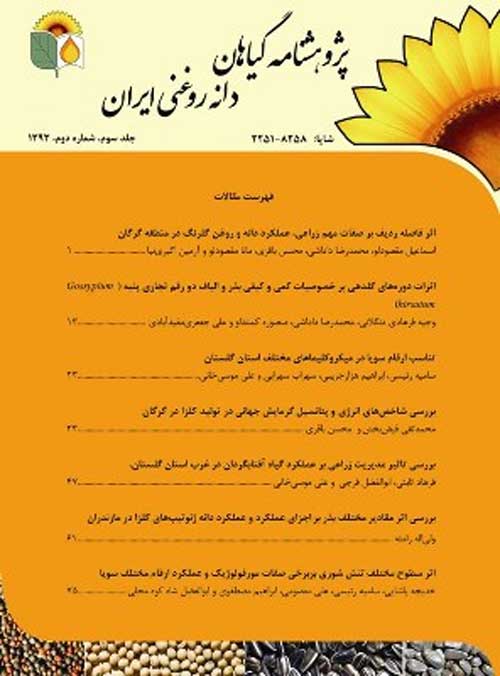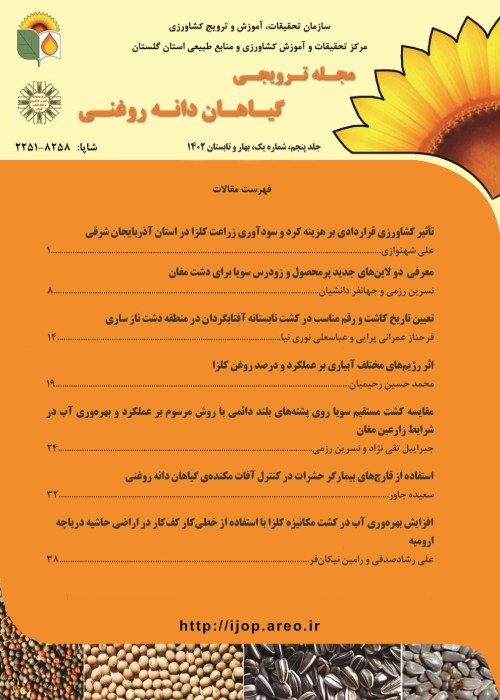فهرست مطالب

نشریه گیاهان دانه روغنی
شماره 1 (1393)
- تاریخ انتشار: 1393/03/30
- تعداد عناوین: 7
-
Page 1In order to evaluate the effect of agronomic management (sowing date, seeding rate and row spacing) on yield components, oil percent and seed and oil yield of canola (RGS003 cultivar), an experiment was conducted at the Agricultural Research Station of Gonbad during 20032005. The experiment was a split plot factorial arranged in an RCBD with four replications. Three sowing dates (Nov. 6th, Nov. 21st and Dec. 6th) were as main plots and three seeding rates (4, 7 and 10 kg/ha) and two row spacing (12 and 24 cm) were subplots in a factorial arrangement. The first sowing date had the highest seed yield, because of suitabletemperature conditions at the beginning of growing season, earlier seedling establishment and higher number of pods per plant. The mean seed yield of first, second and third sowing dates were3512, 2827 and 2742 kg/ha, respectively. The significant difference of year×seeding rate interaction was due to different trend of seed yield variation with seeding rate increase in the two years of the experiment. In the first year of the experiment the seed yield decreased with an increase in increase in seeding rate because of higherlodging, whereas this trend was not observed in the second year of the experiment. The seed yield decreased with an increase inrow spacing. The mean seed yield atrow spacing of 12 and 24 cm was 3158 and 2896 kg/ha, respectively. Finally with regard to two year results of the experiment, the second decade of Aban (Nov. 1st-10th) sowing date, 6-8 kg/ha seeding rate and 12-18 cm row spacing are recommended for canola planting in Gonbad and Kalaleh area and also, RGS003 as a cultivar with good seed yield and agronomiccharacteristics can be planted in the area.Keywords: Canola, Sowing date, Seeding rate, Row spacing, Seed yield
-
Page 13In this study, the energy flow was analyzed in soybean fields of Golestan province. For this purpose, some indexes such as energy use efficiency, net energy, specific energy, energy productivity, direct energy, indirect energy, renewable and non-renewable energy, total energy input and total energy output were calculated. Primary data were obtained through field survey and personal interviews with agricultural specialists and farmers of Golestan province and filling in questionnaires. The data obtained were converted to secondary usable data using energy equivalents from available literature. Analysis of data showed that the greatest contribution to input energy belonged to energy from electricity (43.74%) followed by energy from fuels and chemical fertilizers. In addition, in these fields energy use efficiency was calculated as 2.31. In this study, the average energy productivity was 0.09 Kg MJ-1.This means that 0.09 kg of seed was obtained per unit energy in Golestan soybean fields. Variables of seed, labor force and chemicals were the least demanding energy input for soybean production in this region. Results indicated that 60.78% and 39.22% of total energy input were in renewable and non- renewable forms, respectively.Keywords: Soybean, Energy balance, Energy ratio, Golestan province
-
Page 29In the present study, it was studied whether oil seed (canola, safflower, and sesame) production had any comparative advantage in Kerman province (a case study of cities of Bardsir, Bam and Orzoeiyeh) using two recognition indexes of comparative advantage in 1389-90. The first set of indicators consisted of Social Cost Benefit, Domestic Resource Cost and Net Social Profit and the second setwere Efficiency Advantage, Scale Advantage and Aggregative Advantage Indexes. Based on both absolute and relative shadow exchange rates, only safflower in Bam had the comparative advantage. Based on the second type of indicators, the average performance or efficiency of canola and other oilseeds crops in Kerman province was more than those of the country's average. However, the degree of centralization did not show farmer's preference to grow these crops. The calculated protection coefficients showed that excluding safflower crop, subsidies were paid indirectly to produce other products and as a whole, the government has supported the production of canola and sesame. The policy analysis matrix for all products showed that there was market profit for the producers in the domestic market, in addition, safflower growers have benefited from operating in the free trade.Keywords: Comparative advantage, Kerman province, Oilseeds, Policy Analysis Matrix, Protective policies
-
Page 59
Given the close link between agriculture with other economic sectors, agricultural development can play an important role in the economic prosperity of countries. Protection policies are the most important economic strategies in the agricultural sector in the developing and developed countries. Bearing in mind the central role of agriculture in development of countries, the purpose of this study was to evaluate the percentage of support to producers (% PSE) and the indicators of development, including rates of production, value of production, imports and value of imported soybeans, soybean export volume and export value in order to provide a classification and cluster analysis, and to show the distance based on the these indicators between different countries. The statistical population in this study was the countries that were members of the Organization for Economic Cooperation and Development (OECD) and those countries classified by FAO as the main soybean producing countries. Using cluster analysis based on proximity of the indicators the countries were grouped. The results showed that countries that had high soybean production such as America, Brazil and Argentina their income based on pro international dollars were higher where as producer support was not that high in these countries and were accordingly grouped in weak support category. In contrast, in countries such as South Korea and Japan with lower production, government support was higher and more efficient, this means that a greater percentage of the annual monetary value of gross transfers from government support to producers of soybean.
Keywords: Business Support, Cluster analysis, producer support, soybean -
Page 75
In order to study the effect of Rhizobium bacteria, Mycorrhiza fungus and foliar application of urea on some quantitative and qualitative traits of soybeans under field condition in Ghaemshahr, an experiment was conducted in a Randomized Complete Block design experiment with four replications in 2009. The treatments were1-control(A), 2-Rhizobium bacteria (S), 3-Rhizobium bacteria Mycorrhiza fungus(S), 4-Rhizobium bacteria foliar application of urea (S), 5Rhizobium bacteria ㌧⢮롢 fungus foliar application of urea (S㏥), 6- foliar application of urea (U). The results showed that Rhizobium inoculation, Mycorrhiza fungus and foliar application of urea had not any significant impact on seed yield and yield components of soybean, but it had significant effect onseed protein contents, seed oil and seed number per pod on lateral branches. The results revealed that symbiosis of Rhizobium and Mycorrhiza and foliar application of urea at flowering had significant effect on oil and protein content, and soybean yield and it increased seed number per pods. The leaf area index determined during the the growing season showed that the treatment (S㏥) increased LAI. The highest LAI was produced at 80 days after planting date followed by U treatments at90 days after planting date. The highest dry matter (DM)was produced at treatment S. Plant height, nodule numbers, nodules dry matter had an ascending trend during the growth season in all treatments, M showed the highest plant height at while the control had the lowest plant height, S and M䯥 had the highest nodules dry weight. The control (A) had the lowest nodule dry weight.
Keywords: Agronomic characteristic, Foliar application of urea, Mycorrhiza fungus, Soybean, Yield -
Page 89
In order to study the effects of different sowing dates and plant densities on soybean genotypes, an experiment was carried out in arandomized complete block design, arranged in asplit split plot design with four replications at the Agricultural Research Station of Baykola. Main plot was planting dates including 20 April, 20 May and 20 June, sub plots wereplant densities including 32, 40 and 48 plants per square meter and sub sub plots were soybean genotypes: Sari, Nekador and line 2002. Results showed that with a delay in planting date, most of the traits studied were decreased and consequently seed yield decreased. At the third planting datecompare to the first planting date, pods per plant, pods per main stem, seeds per pod and seed yield decreased 32.35, 22.29, 40.21, 46.85, 10.57 and 42.29%, respectively. Although there were significant differences among genotypes for some yield components, but there was not any significant difference among genotypes for seed yield. The average seed yields of genotypes at the first, second and third planting dates were 3235, 2577 and 1867 kg ha-1, respectively and they were also classified asthree different statistical groups. Due to non-significant effect of plant densiy on seed yield, for reduction of seed cost, 32 plants per square meter can be recommended.
Keywords: yield components, plant density, sowing date, soybean, seed yield -
Page 101
Pythium ultimum is a fungus pathogen that attacks many crop species such as safflower and causes damping-off. The most important method for controlling and reducing disease damages is using of genotypes with resistance genes those are either local or breeding varieties. This study was conducted in Gorgan University of Agricultural Sciences and Natural Resources to identify molecular markers associated with Pythium ultimum resistance genes in safflower. To study response to the pathogen, two genotypes (a resistant cultivar and a susceptible line) and F1 and F2 generation derived of their crosses were used. First of all by using of infected environment, F2 populations were divided into two bulks of resistant and susceptible seedlings. Suspension of 105zoospore per ml was applied to inoculate the seedlings. Symptoms of the disease were observed as seedling and root rot and also seedling damping off. In infected environment, resistant cultivar was superior than susceptible line in terms of mortality rate of seedlings; this proves the potential of resistance against pathogen in the former genotype. In order to genotyping and identify polymorphisms, the populations were grouped using bulk segregation analysis and F2 population was genotyping by using of 24 ISSR primers that used on safflower before. Based on the results, three ISSR primers showed association with resistance gene and one primer had linkage to susceptibility. The bands associated with resistance genes were observed in resistant parent, F1 and F2resistance bulk but not in susceptible parent and F2susceptible bulk. These markers can be used for finding resistance genes to Pythium ultimum in safflower and other crops.
Keywords: ISSR, Zoospore, Resistance, Gene


